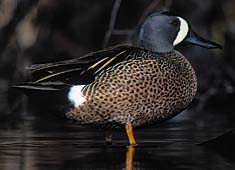|
|
 |
 | |
|
Cross Timbers Ducks
While there are a growing number of duck hunters in the region, duck hunting is not as popular as deer or quail hunting. Thus there's often land available for duck hunting where other hunting opportunities don't exist. Many landowners will lease their lakes and ponds for duck hunting.
The Cross Timbers is also one area of Texas in which members of Ducks Unlimited can take pride. In 1996, Ducks Unlimited and the Texas Parks and Wildlife Department spent over $60,000 to build 105 acres of new wetlands on Lake Proctor, with help from the United State Army Corps of Engineers, which manages the lake. Those areas were off-limits for hunting last year - and drew hundreds of ducks. This year, the Corps is planning to build permanent blinds which will be offered on a first-come, first-served basis. Call the Proctor Corps office for more information. Proctor was a legendary duck hunting spot during the 1970s, drawing up to 100,000 wintering mallards each fall. While they're not yet back to that number, mallard numbers have increased dramatically at Proctor over the past four years. Decoying is not the only effective technique for Cross Timbers ducks. Jump-shooting small tanks can be superb. One December afternoon, several friends invited me along to jumpshoot some ponds in Comanche County, west of Stephenville. We crept up behind the dam of one tank, in the middle of a large ranch, with no other water around. The constant chatter of ducks, just out of sight, told us what to expect. But it was still hard to comprehend the cloud of mallards and widgeons that exploded almost in our faces when we jumped up. I knocked down three mallards in the blink of an eye, as did each of my companions. When the feathers had settled, we gathered up a dozen mallards and one widgeon drake from less than five seconds of shooting. Regardless of how you plan to hunt small waters in this area, scout the lake or pond before you hunt it. Try to identify where the ducks are working, where you have cover for either a sneak or to build a blind and what kind of ducks they are. I know a couple of lakes that are covered with ducks each fall - and every one a shoveler! When setting a decoy spread, it's a lot easier to decoy ducks to a spot they've already used and really want to revisit. In jumpshooting, since you only get one chance, be sure your approach will be completely camouflaged. There's nothing worse than watching a hundred ducks flush 100 yards away because they spotted you before you could sneak into range. Back to that incredible duck hunting morning with Ron and Calvin near Stephenville: Ron is an Stephenville elementary school principal, while Calvin teaches high school agriculture classes. They both devote every possible minute to duck hunting. As it grew lighter, we watched more and more ducks quacking and flushing from the lake - lots of ducks. "They'll be back," Calvin said. "Let's get set." We'd only been in hiding for a few moments when smaller flocks of eight to 12 mallards began to return, riding the gusting wind. Many headed to the other side of the lake. But enough did swing over our spread and decoy to provide a half-hour of fast shooting. However, the most amazing sight of all was the return of the pintails at about 9 a.m. - hundreds, maybe thousands of them in one flock. And of course they pitched in right in the center of the lake, a good 200 yards away! (Editor's Note: For information on duck hunting in the Cross Timbers, call Harry Wayne Cloud, Indian Creek Guide Service (915-356-5705) in Comanche or Bobby Pettijohn, Flying P Outdoors (254-796-4034) in Hico.)
|
|
|
| |
Site design by Copyright © 1996-2007 Outdoor Management Network Inc. America Outdoors® is a registered trademark of Outdoor Management Network Inc. |
 Most major reservoirs in the region allow waterfowl hunting. Some, like Richland Chambers and Proctor, can be hunted by foot, walking into a likely hunting area on a cove. All can be hunted by using a boat to ferry you back into a promising locale. You can't hunt from your boat, but can stash it nearby, set out your decoys and rig a temporary blind. Most lakes which allow hunting also limit building permanent blinds, so be sure to check the rules first.
Most major reservoirs in the region allow waterfowl hunting. Some, like Richland Chambers and Proctor, can be hunted by foot, walking into a likely hunting area on a cove. All can be hunted by using a boat to ferry you back into a promising locale. You can't hunt from your boat, but can stash it nearby, set out your decoys and rig a temporary blind. Most lakes which allow hunting also limit building permanent blinds, so be sure to check the rules first.